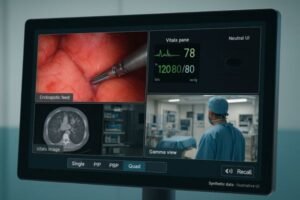Are you concerned that the medical monitor you rely on for critical diagnoses might lose its brightness over time, potentially affecting your ability to see subtle but crucial details? This degradation can lead to diagnostic uncertainty and increased visual strain. As someone dedicated to advancing medical display technology at Reshin, I know this is a valid worry. The good news is that professional medical monitors are specifically engineered to address this, employing sophisticated technologies to ensure consistent luminance throughout their operational life.
Yes, professional medical monitors are designed to maintain screen brightness for extended periods. They achieve this through integrated technologies such as automatic brightness stabilization (ABS) systems, high-quality LED backlights with minimal decay characteristics, ambient light sensors, and often internal front sensors for continuous calibration. These features work together to counteract the natural dimming that can occur with prolonged use, ensuring reliable diagnostic image quality.
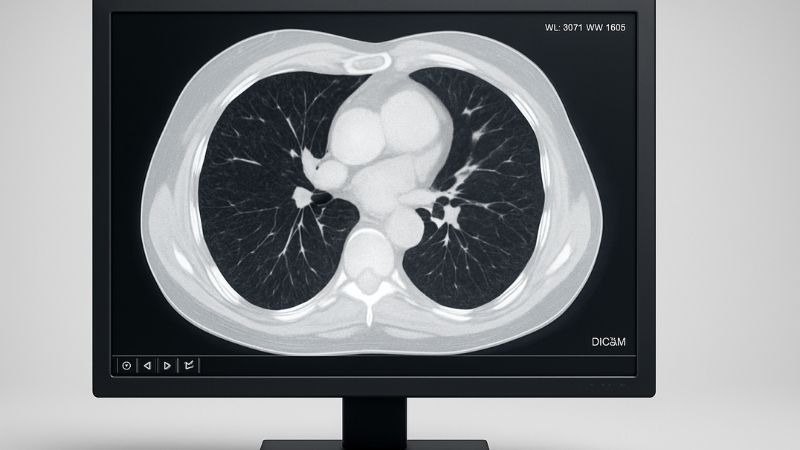
This consistent performance is not just a convenience; it’s a cornerstone of accurate medical imaging. Let’s delve into how this is achieved.
How do professional medical monitors ensure consistent brightness over time?
Medical professionals worry that a monitor’s brightness might fade, compromising diagnostic accuracy. This fear is understandable, as consistent image presentation is crucial. Professional monitors use advanced internal systems to counteract this.
Professional medical monitors ensure consistent brightness primarily through built-in luminance stabilization circuits and sensors that actively monitor and adjust the backlight output in real time, compensating for age-related decay or temperature fluctuations.
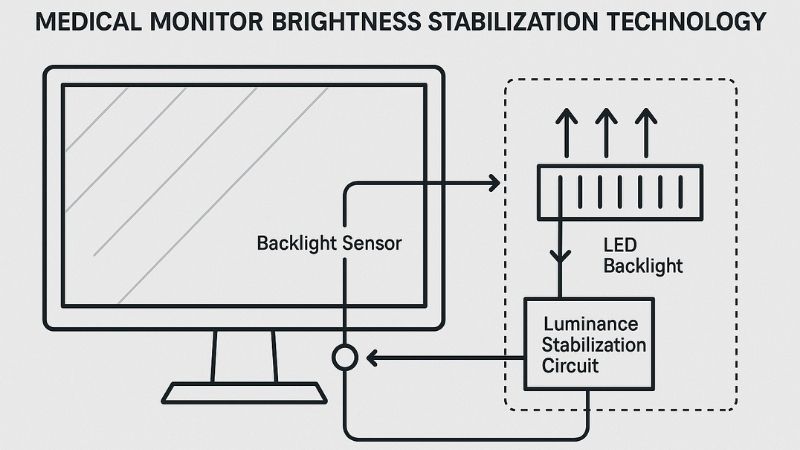
At Reshin, we’ve spent years perfecting these systems. The core of brightness consistency lies in a multi-faceted approach. Firstly, we utilize Automatic Brightness Stabilization (ABS)1 or similar luminance stabilization circuits. These are sophisticated electronic systems that continuously monitor the light output of the backlight. If any deviation from the calibrated set point is detected—perhaps due to the natural aging of the LED components or minor temperature variations—the circuit automatically adjusts the power to the backlight to restore the target brightness. This is a dynamic, ongoing process.
Secondly, the quality of the components themselves is paramount. We select high-quality, long-life LED backlights2 known for their slow degradation curves. Paired with robust power supply units designed for stable output, this forms a solid foundation.
Thirdly, many of our advanced diagnostic monitors, like the Reshin MD52G 5MP Grayscale Mammography Monitor or the MD120C 12MP High-Precision Diagnostic Monitor, incorporate built-in front sensors or backlight sensors3. These sensors provide direct feedback to the stabilization system, allowing for even more precise and continuous calibration. This ensures that the brightness you see on day one is remarkably close to what you see years later. Factory calibration also plays a key role, setting an accurate baseline that these systems then work to maintain.
| Technology Component | Function | Benefit for Brightness Consistency |
|---|---|---|
| Luminance Stabilization Circuit | Actively monitors and adjusts backlight power | Real-time compensation for brightness drift |
| High-Quality LED Backlights | Slower degradation rate, stable light output | Longer lifespan at consistent brightness |
| Built-in Sensors (Front/Backlight) | Provide direct feedback on actual light output to the calibration system | Continuous self-correction, high accuracy |
| Temperature Control Systems | Manage internal heat to prevent brightness fluctuations due to heat | Stable performance in varied conditions |
This combination of technologies ensures that clinicians can trust the image they are viewing, day in and day out.
Why is long-term brightness stability important in clinical diagnostics?
In clinical settings, especially radiology, subtle changes in an image can indicate significant pathology. If a monitor’s brightness fades unevenly or unpredictably, these critical visual cues could be missed, directly impacting patient care.
Long-term brightness stability is vital because it ensures that diagnostic images are displayed consistently every time, allowing for accurate detection of subtle pathologies and reliable comparison with prior studies, crucial for tracking disease progression.
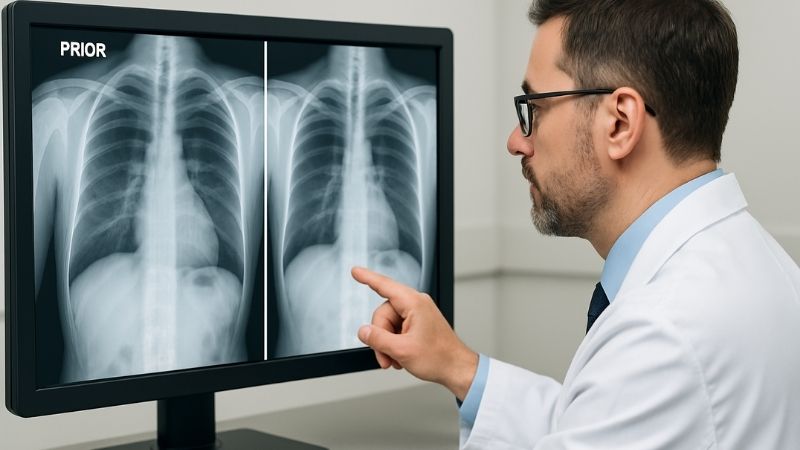
My experience in surgical imaging systems4 and now as President of Reshin has consistently reinforced the critical nature of stable image presentation5. Consider a radiologist like Dr. Amy Chen, who is responsible for ensuring precise performance of imaging systems. She needs to compare a patient’s current CT scan with one taken six months or a year ago. If the monitor’s brightness has degraded, a lesion that was faintly visible on the previous scan might now appear less conspicuous, or vice-versa, leading to misinterpretation of disease progression or stability. This is particularly true for low-contrast lesions6 often encountered in oncology or subtle fractures in orthopedics.
Long-term brightness stability directly supports:
- Accurate Longitudinal Assessment: Tracking changes over time is a cornerstone of managing chronic conditions or evaluating treatment efficacy. Consistent brightness ensures that any perceived change is due to the patient’s condition, not monitor variability.
- Diagnostic Confidence: Clinicians must trust what they see. A stable display allows them to focus on interpretation without subconsciously compensating for display deficiencies.
- Inter-Observer Consistency: When multiple physicians review the same images on different occasions or different but similarly calibrated displays, brightness stability contributes to more consistent interpretations.
- Reduced Visual Fatigue: A display that maintains its calibrated brightness is more comfortable to view over long reporting sessions, as the eyes are not constantly trying to adapt to a dimming or fluctuating image.
- DICOM Compliance: As we’ll discuss later, standards like DICOM Part 14 rely on consistent luminance characteristics for accurate grayscale reproduction.
Without this stability, the diagnostic value of even the highest resolution monitor diminishes over time. This is a core principle behind Reshin’s mission to provide high-quality, reliable display solutions.
What technologies does Reshin use to reduce brightness decay in medical monitors?
Clinicians depend on their monitors day in and day out. The concern that a display’s performance, especially brightness, might degrade significantly over its lifespan is a major factor in purchasing decisions. Reshin directly addresses this through robust engineering.
Reshin employs advanced luminance stabilization circuits, integrated real-time calibration sensors (both front and backlight sensors in select models), and premium-quality, long-life LED components to actively combat brightness decay in its medical monitors.
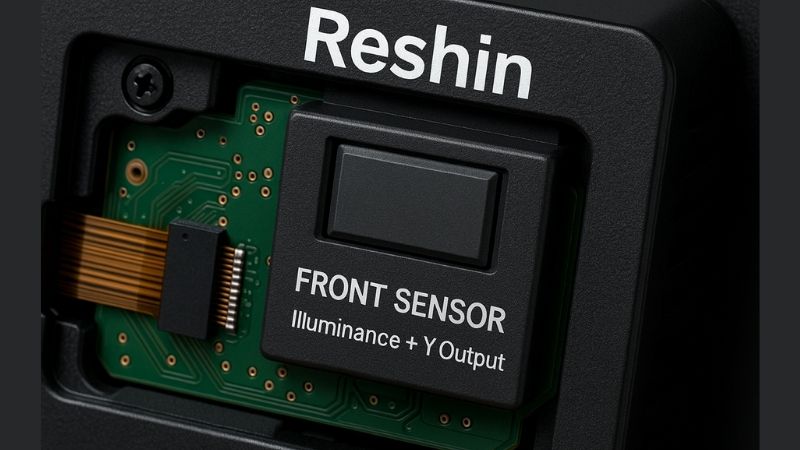
At Reshin, our R&D team, with over 200 members each boasting more than a decade of experience, has developed several proprietary and integrated technologies to ensure long-term brightness stability. Our commitment is reflected in over 100 technology patents and copyrights, many related to image quality and display reliability.
Key Reshin technologies include:
- Dynamic Luminance Control (DLC)7: This is our sophisticated system that often incorporates both backlight monitoring and, in high-end models like the Reshin MD120C, a front-mounted sensor. The front sensor periodically measures the actual light output from the screen surface and feeds this data back to the internal calibration engine. This allows the monitor to self-correct for any drift in brightness or color temperature, ensuring it stays true to its initial DICOM calibration or user-defined settings.
- Smart Backlight Management8: We utilize advanced LED driver technology that not only provides stable power but also intelligently manages the LEDs to prolong their lifespan while maintaining consistent output. This includes thermal management to prevent overheating, a common cause of premature LED degradation.
- High-Efficiency, Low-Degradation LEDs9: The choice of LED components is critical. Reshin sources LEDs specifically designed for medical applications, characterized by very slow brightness decay curves and stable color points over tens of thousands of hours.
- Uniformity Correction: Beyond just overall brightness, maintaining brightness uniformity across the entire screen is crucial. Our systems work to ensure that the center of the screen is just as bright as the corners, and this uniformity is maintained over time.
For example, our diagnostic monitors, such as the MD26C or the MD50C 5MP Color Mammography Monitor, are built with these principles at their core. Similarly, surgical displays like the MS275P 27" 4K Surgical Monitor or the larger MS550P 55" 4K Surgical Monitor, benefit from these technologies to ensure surgeons like Dr. Emily Chen have a consistent, clear view in the OR. This focus on longevity and stability is one reason why global brands like Philips and Fujifilm trust Reshin for their display needs.
Do backlight sensors help maintain brightness consistency?
Medical professionals might wonder about the specific mechanisms ensuring their display remains bright. Backlight sensors are one such technology, but how effective are they? They are indeed a key component in the fight against brightness degradation.
Yes, backlight sensors play a crucial role by continuously monitoring the light output directly from the LED backlight system and enabling the monitor to make real-time adjustments, compensating for aging or temperature-induced variations.
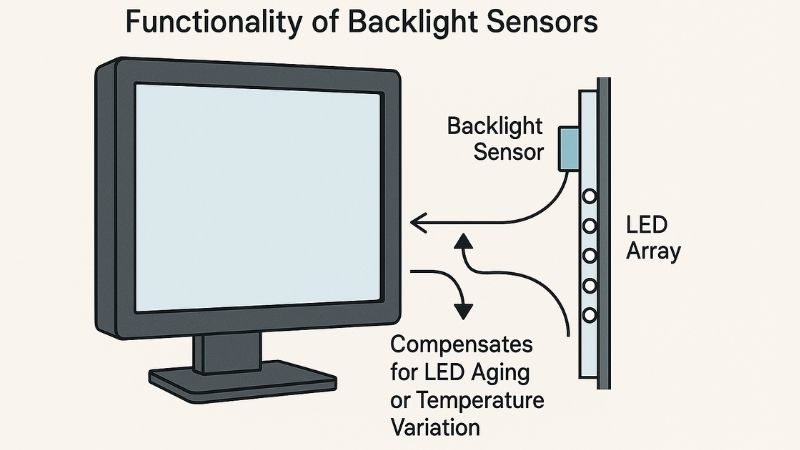
Backlight sensors are a smart piece of engineering that significantly contributes to maintaining consistent brightness. Positioned internally, close to the LED light source, these sensors constantly measure the intensity of the light being produced by the backlight unit before it passes through the LCD panel and other optical films. This direct measurement of the source is crucial.
Here’s how they contribute to brightness consistency:
- Compensation for LED Aging10: All LEDs naturally dim over their lifespan. A backlight sensor detects this gradual reduction in light output and signals the monitor’s internal circuitry to increase power to the LEDs, bringing the brightness back to the calibrated level. This effectively extends the period during which the monitor can maintain its target luminance.
- Temperature Fluctuation Adjustments: LED light output can also be affected by temperature changes within the monitor. As the monitor warms up during use, or if the ambient room temperature changes, the backlight sensor detects any resultant brightness shifts and triggers compensatory adjustments.
- Enhanced Stability: By providing a continuous feedback loop, backlight sensors11 help the monitor maintain a much more stable brightness level compared to systems without such active monitoring. This reduces short-term fluctuations as well as long-term decay.
While front sensors (which measure light from the screen surface) provide a more comprehensive calibration that includes the characteristics of the LCD panel itself, backlight sensors are excellent for specifically managing the consistency of the light source. Many of Reshin’s diagnostic monitors, including several models in our MD series, incorporate intelligent backlight sensing technology as part of their overall brightness stabilization strategy12. For instance, the "intelligent backlight sensors" mentioned in the general introduction to our Radiology Displays are precisely these kinds of components, working tirelessly to ensure reliability. This is a feature that an OEM Purchasing Manager like Alex Müller would appreciate, as it contributes to the long-term reliability and consistent performance of the displays integrated into Mediview Technologies’ imaging systems.
How does brightness stability impact DICOM compliance and image accuracy?
DICOM compliance is fundamental for medical imaging. Any deviation, such as unstable brightness, can undermine this standard. This directly affects how accurately images are perceived, potentially leading to diagnostic errors.
Brightness stability is critical for DICOM Part 14 compliance, as this standard mandates specific luminance levels for accurate grayscale reproduction. Fluctuations can alter perceived image contrast and detail, compromising diagnostic accuracy.
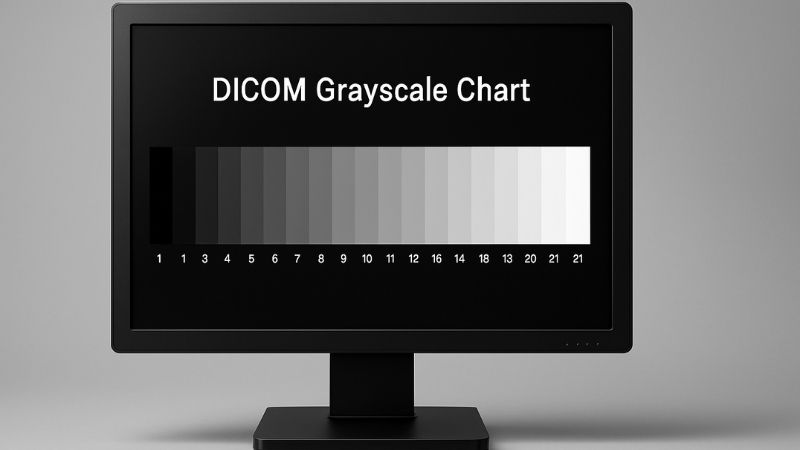
I’ve always emphasized that DICOM compliance13 isn’t just a checkbox; it’s a commitment to patient safety. DICOM (Digital Imaging and Communications in Medicine) Part 14 specifies a Grayscale Standard Display Function14 (GSDF). This standard dictates how pixel values in a digital medical image should be translated into specific luminance levels on a display. The goal is to ensure perceptual linearization – meaning that changes in image data are perceived consistently by the human eye, regardless of the monitor, as long as it’s DICOM calibrated.
Brightness stability is intrinsically linked to maintaining this GSDF calibration over time. Here’s why:
- Maintaining the Calibrated Luminance Range: DICOM calibration sets specific minimum (Lmin) and maximum (Lmax) luminance levels, and a precise curve between them. If the monitor’s maximum brightness decays, it can no longer accurately reproduce the brighter shades of gray as defined by the GSDF. This can lead to loss of detail in brighter areas of an image.
- Ensuring Contrast Fidelity: The GSDF is crucial for consistent contrast display. If brightness is unstable, the perceived contrast between different tissues or subtle lesions can change, making it harder to detect abnormalities or compare studies accurately. A monitor that fails to maintain its calibrated brightness may no longer be truly "DICOM compliant" in practice, even if it was at the time of its last manual calibration.
- Impact on Just Noticeable Differences (JNDs): The GSDF is based on JNDs, ensuring that steps in grayscale are visually distinct. Brightness instability can compress or expand these JNDs, making it harder to discern subtle differences critical for diagnosis. My earlier insight about a monitor degrading in clinical value without brightness maintenance is particularly relevant here.
Reshin’s diagnostic monitors, like the MD33G 3MP Grayscale Diagnostic Monitor or the high-resolution 8MP Diagnostic Display, are designed with DICOM Part 14 compliance as a foundational requirement. Our factory calibration processes are rigorous, and the built-in stabilization technologies, including sensors, are there to ensure this compliance is maintained for as long as possible. This commitment means that clinicians like Dr. Amy Chen can trust that the Reshin monitors they use will display images accurately and consistently, not just on day one, but throughout their service life, thereby upholding the integrity of the diagnostic process. This reliability is also crucial for distributors like Luis Herrera, who need to assure their hospital clients of long-term image quality and adherence to international standards.
Conclusion
Professional medical monitors are indeed engineered for long-term brightness stability, using advanced sensors and stabilization circuits. This ensures reliable, DICOM-compliant image display crucial for accurate clinical diagnosis and consistent patient care. For dependable displays with intelligent brightness stabilization, contact Reshin at martin@reshinmonitors.com.
-
Explore this link to understand how ABS technology enhances display quality and maintains brightness consistency over time. ↩
-
Learn about the advantages of using premium LED backlights for better performance and longevity in displays. ↩
-
Discover how these sensors contribute to precise calibration and long-term brightness stability in monitors. ↩
-
Explore this link to understand how innovations in surgical imaging systems can enhance diagnostic accuracy and patient outcomes. ↩
-
Learn about the significance of stable image presentation in medical imaging and its impact on diagnosis and treatment. ↩
-
Discover techniques for identifying low-contrast lesions, crucial for accurate diagnosis in oncology and orthopedics. ↩
-
Explore this link to understand how DLC enhances image quality and maintains brightness stability in monitors. ↩
-
Learn about Smart Backlight Management and its role in prolonging LED lifespan while ensuring consistent output. ↩
-
Discover the advantages of using High-Efficiency, Low-Degradation LEDs in medical applications for better performance. ↩
-
Learn about the impact of LED aging on display performance and how backlight sensors compensate for it. ↩
-
Explore this link to understand the technology behind backlight sensors and their role in maintaining brightness consistency in displays. ↩
-
Discover the importance of brightness stabilization strategies in monitors and how they enhance display quality and reliability. ↩
-
Understanding DICOM compliance is essential for ensuring patient safety and accurate medical imaging. Explore this resource to learn more. ↩
-
The GSDF is vital for accurate image display in diagnostics. Discover its significance and applications in this informative link. ↩

